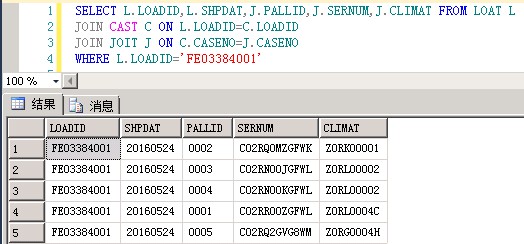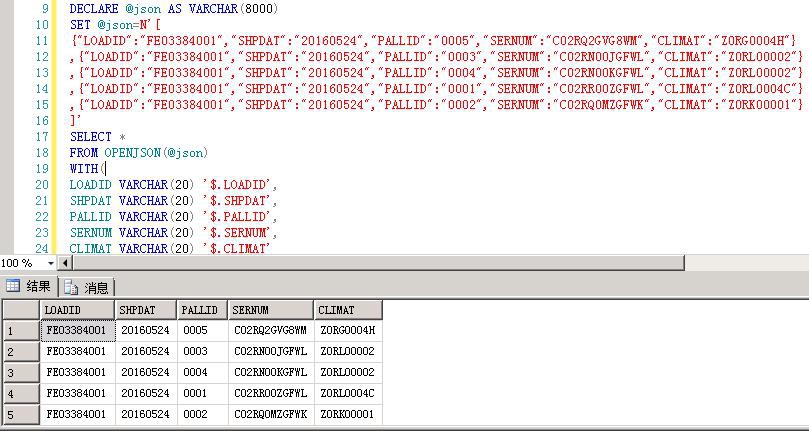SQL Server中JSON函数的用法详解
SQL Server 2005开始支持XML数据类型,提供原生的XML数据类型、XML索引及各种管理或输出XML格式的函数。
随着JSON的流行,SQL Server 2016开始支持JSON数据类型,不仅可以直接输出JSON格式的结果集,还能读取JSON格式的数据。
下面是我们熟悉的SELECT及输出格式,后面对JSON的演示基于此SQL:

一、 将查询结果输出JSON格式
1、FOR JSON AUTO:SELECT语句的结果以JSON输出。
要将SELECT语句的结果以JSON输出,最简单的方法是在后面加上 FOR JSON AUTO :

2、FOR JSON AUTO,Root(’’) :为JOSN加上根节点
若要为FOR JSON加上Root Key,可以用ROOT选项来自定义ROOT 节点的名称:

3、FOR JSON PATH输出:可通过列别名来定义JSON对象的层次结构
若要自定义输出JSON格式的结构时,必须使用JSONPATH。
- FOR JSON Auto,自动按照查询语句中使用的表结构来创建嵌套的JSON子数组,类似于For Xml Auto特性。
- FOR JSON Path,通过列名或者列别名来定义JSON对象的层次结构,列别名中可以包含“.”,JSON的成员层次结构将会与别名中的层次结构保持一致。
这个特性非常类似于早期SQL Server版本中的For Xml Path子句,可以使用斜线来定义xml的层次结构。

4、FOR JSON PATH+ROOT输出:为JOSN加上根节点

5、INCLUDE_NULL_VALUES:值null的字段需要显示出现。
为NULL的数据在输出JSON时,会被忽略,若想要让NULL的字段也显示出来,可以加上选项INCLUDE_NULL_VALUES,该选项也适用于AUTO。

6、列的别名,可以增加带有层级关系的节点。
比如下面的SQL,增加了一个“SN”节点,把栏位SERNUM和CLIMAT放在里面:

演示实例:
1 select TOP (2) id, Plies, Createtime from [dbo].[B3PliesData] ORDER BY ID ; 2 --1178 3 2020-07-21 14:33:18.480 3 --1179 3 2020-07-21 14:36:27.457 4 5 select TOP (2) id, Plies as [myObject.Plies], Createtime as [myObject.Createtime] from [dbo].[B3PliesData] ORDER BY ID for json auto; 6 --[{"id":1178,"myObject.Plies":3,"myObject.Createtime":"2020-07-21T14:33:18.480"},{"id":1179,"myObject.Plies":3,"myObject.Createtime":"2020-07-21T14:36:27.457"}] 7 8 select TOP (2) id, Plies, Createtime from [dbo].[B3PliesData] ORDER BY ID for json auto ,root('myRoot') ; 9 --{"myRoot":[{"id":1178,"Plies":3,"Createtime":"2020-07-21T14:33:18.480"},{"id":1179,"Plies":3,"Createtime":"2020-07-21T14:36:27.457"}]} 10 11 select TOP (2) id, Plies as [myObject.Plies], Createtime as [myObject.Createtime] from [dbo].[B3PliesData] ORDER BY ID for json path; 12 --[{"id":1178,"myObject":{"Plies":3,"Createtime":"2020-07-21T14:33:18.480"}},{"id":1179,"myObject":{"Plies":3,"Createtime":"2020-07-21T14:36:27.457"}}] 13 14 select TOP (2) id, Plies, Createtime,null as mynull from [dbo].[B3PliesData] ORDER BY ID for json path,root('myRoot'); 15 --{"myRoot":[{"id":1178,"Plies":3,"Createtime":"2020-07-21T14:33:18.480"},{"id":1179,"Plies":3,"Createtime":"2020-07-21T14:36:27.457"}]} 16 17 select TOP (2) id, Plies, Createtime,null as mynull from [dbo].[B3PliesData] ORDER BY ID for json path,root('myRoot'),include_null_values; 18 --{"myRoot":[{"id":1178,"Plies":3,"Createtime":"2020-07-21T14:33:18.480","mynull":null},{"id":1179,"Plies":3,"Createtime":"2020-07-21T14:36:27.457","mynull":null}]}
二、 解析JSON格式的数据
1、使用OPENJSON()函数:

2、通过WITH选项,自定义输出列:

实例演示:
1 -------------1、------------- 2 declare @json as varchar(8000) 3 set @json='[ 4 {"id":1178,"myObject.Plies":3,"myObject.Createtime":"2020-07-21T14:33:18.480"}, 5 {"id":1179,"myObject.Plies":3,"myObject.Createtime":"2020-07-21T14:36:27.457"}]' 6 select * from openjson(@json); 7 --key value type 8 --0 {"id":1178,"myObject.Plies":3,"myObject.Createtime":"2020-07-21T14:33:18.480"} 5 9 --1 {"id":1179,"myObject.Plies":3,"myObject.Createtime":"2020-07-21T14:36:27.457"} 5 10 11 -------------2、------------- 12 declare @json1 as varchar(8000) 13 set @json1='[ 14 {"id":1178,"myObject.Plies":3,"myObject.Createtime":"2020-07-21T14:33:18.480"}, 15 {"id":1179,"myObject.Plies":3,"myObject.Createtime":"2020-07-21T14:36:27.457"}] 16 ' 17 select * from openjson(@json1) 18 with( 19 id varchar(10) '$.id', 20 Plies int '$."myObject.Plies"', 21 Createtime datetime '$."myObject.Createtime"' 22 ); 23 --id Plies Createtime 24 --1178 3 2020-07-21 14:33:18.480 25 --1179 3 2020-07-21 14:36:27.457 26 27 -------------3、------------- 28 declare @json2 as varchar(8000) 29 set @json2='{"myRoot":[ 30 {"id":1178,"myObject":{"Plies":3,"Createtime":"2020-07-21T14:33:18.480"}}, 31 {"id":1179,"myObject":{"Plies":3,"Createtime":"2020-07-21T14:36:27.457"}} 32 ]}' 33 34 select * from openjson(@json2,'$.myRoot') 35 with( 36 id varchar(10) , 37 Plies int '$.myObject.Plies', 38 Createtime datetime '$.myObject.Createtime' 39 ); 40 --id Plies Createtime 41 --1178 3 2020-07-21 14:33:18.480 42 --1179 3 2020-07-21 14:36:27.457
三、JSON函数
1 declare @param nvarchar(max); 2 3 set @param = N'{ 4 "info":{ 5 "type":1, 6 "address":{ 7 "town":"Bristol", 8 "county":"Avon", 9 "country":"England" 10 }, 11 "tags":["Sport", "Water polo"] 12 }, 13 "type":"Basic" 14 }';
1、ISJSON:测试字符串是否包含有效 JSON。
print iif(isjson(@param) > 0, 'OK', 'NO');
返回:OK
2、JSON_VALUE :从 JSON 字符串中提取标量值。
1 print json_value(@param, '$.info.address.town'); 2 print json_value(@param, '$.info.tags[1]');
返回:Bristol,Water polo
3、JSON_QUERY :从 JSON 字符串中提取对象或数组。返回类型为 nvarchar(max) 的 JSON 片段
print json_query(@param, '$.info');
1 { 2 "type":1, 3 "address":{ 4 "town":"Bristol", 5 "county":"Avon", 6 "country":"England" 7 }, 8 "tags":["Sport", "Water polo"] 9 }
4、JSON_MODIFY :更新 JSON 字符串中属性的值,并返回已更新的 JSON 字符串。
print json_modify(@param, '$.info.address.town', 'London');
返回:
1 { 2 "info":{ 3 "type":1, 4 "address":{ 5 "town":"London", 6 "county":"Avon", 7 "country":"England" 8 }, 9 "tags":["Sport", "Water polo"] 10 }, 11 "type":"Basic" 12 }
实例演示:
1 declare @param nvarchar(max); 2 set @param=N'{ 3 "info":{ 4 "type":1, 5 "address":{ 6 "town":"Bristol", 7 "county":"Avon", 8 "country":"England" 9 }, 10 "tags":["Sport", "Water polo"] 11 }, 12 "type":"Basic" 13 }'; 14 15 print iif(isjson(@param)>0, 'OK', 'NO'); 16 print json_query(@param); 17 print json_value(@param, '$.info.address.town'); 18 print json_value(@param, '$.info.tags[1]'); 19 print json_query(@param, '$.info'); 20 print json_query('["2020-1-8","2020-1-9"]'); 21 print json_modify(@param, '$.info.address.town', 'London');
四、注意事项
SQL2016 中的新增的内置JSON进行了简单介绍,主要有如下要点:
- JSON能在SQLServer2016中高效的使用,但是JSON并不是原生数据类型;
- 如果使用JSON格式必须为输出结果是表达式的提供别名;
- JSON_VALUE 和 JSON_QUERY 函数转移和获取Varchar格式的数据,因此必须将数据转译成你需要的类型。
- 在计算列的帮助下查询JSON可以使用索引进行优化。
到此这篇关于SQL Server使用JSON函数的文章就介绍到这了。希望对大家的学习有所帮助,也希望大家多多支持。






【推荐】国内首个AI IDE,深度理解中文开发场景,立即下载体验Trae
【推荐】编程新体验,更懂你的AI,立即体验豆包MarsCode编程助手
【推荐】抖音旗下AI助手豆包,你的智能百科全书,全免费不限次数
【推荐】轻量又高性能的 SSH 工具 IShell:AI 加持,快人一步
· 开发者必知的日志记录最佳实践
· SQL Server 2025 AI相关能力初探
· Linux系列:如何用 C#调用 C方法造成内存泄露
· AI与.NET技术实操系列(二):开始使用ML.NET
· 记一次.NET内存居高不下排查解决与启示
· 被坑几百块钱后,我竟然真的恢复了删除的微信聊天记录!
· 没有Manus邀请码?试试免邀请码的MGX或者开源的OpenManus吧
· 【自荐】一款简洁、开源的在线白板工具 Drawnix
· 园子的第一款AI主题卫衣上架——"HELLO! HOW CAN I ASSIST YOU TODAY
· Docker 太简单,K8s 太复杂?w7panel 让容器管理更轻松!